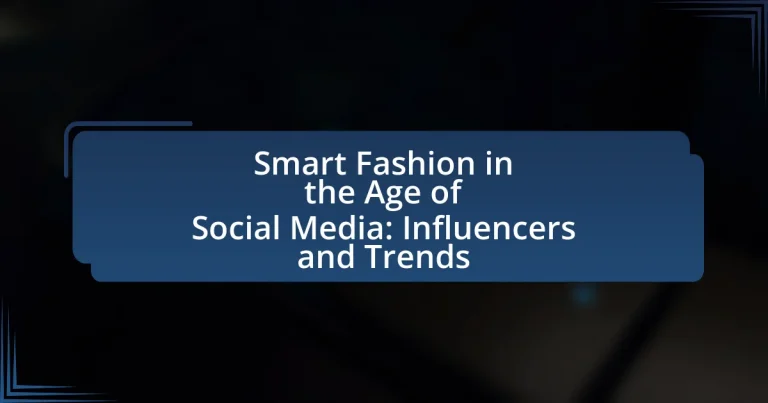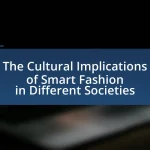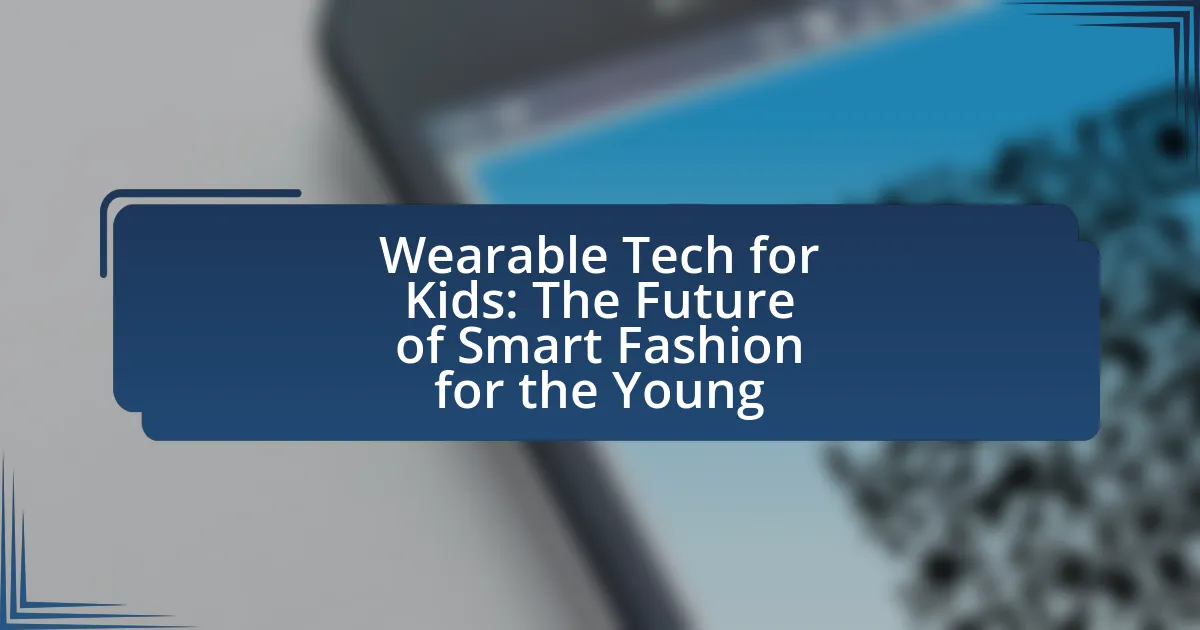Smart fashion in the age of social media represents the convergence of technology and fashion, where brands leverage platforms like Instagram and TikTok to engage consumers and promote trends. The article explores how social media influences the evolution of smart fashion, highlighting the role of influencers in shaping consumer behavior and driving demand for innovative clothing technologies. Key characteristics of smart fashion today include the integration of wearable technology, sustainability, and personalization, while current trends emphasize the importance of user-generated content and the impact of social media algorithms on visibility. Additionally, the article discusses the challenges influencers face, strategies for brands to optimize their reach, and future trends expected in the smart fashion landscape.
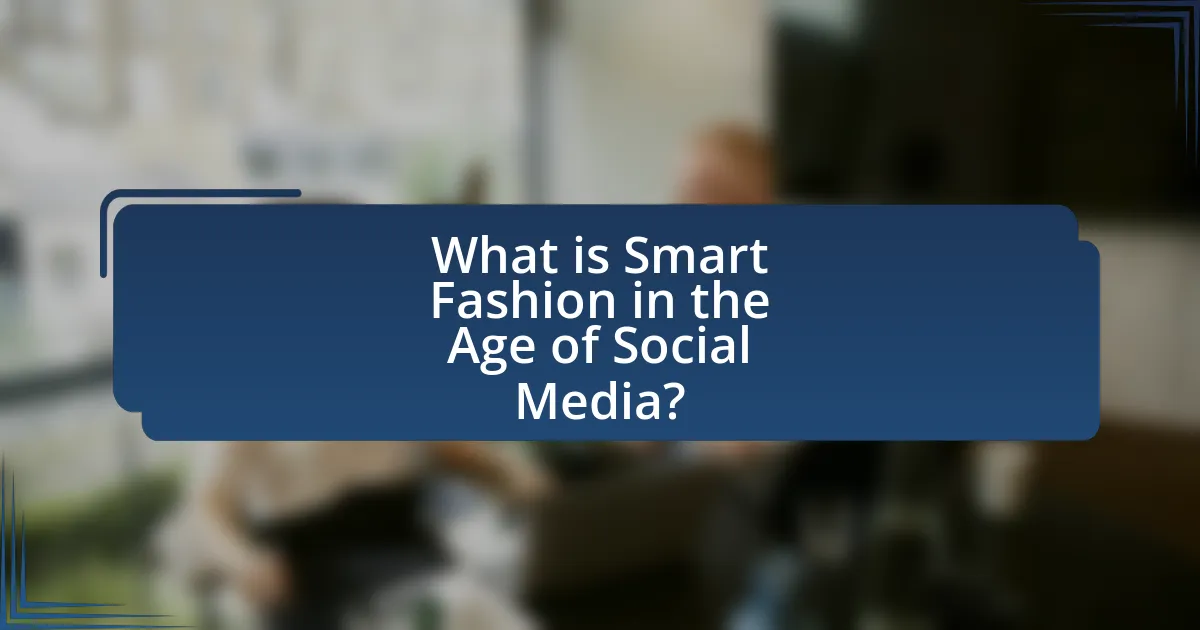
What is Smart Fashion in the Age of Social Media?
Smart fashion in the age of social media refers to the integration of technology and digital platforms into the fashion industry, enabling brands and consumers to interact in innovative ways. This phenomenon is characterized by the use of social media influencers to promote trends, engage audiences, and drive sales, with platforms like Instagram and TikTok playing pivotal roles. For instance, a study by the Fashion Institute of Technology found that 70% of consumers are influenced by social media when making fashion purchases, highlighting the significant impact of digital engagement on consumer behavior.
How has social media influenced the evolution of smart fashion?
Social media has significantly influenced the evolution of smart fashion by facilitating rapid trend dissemination and consumer engagement. Platforms like Instagram and TikTok enable brands to showcase innovative smart clothing technologies, such as wearable tech and sustainable materials, directly to a global audience. This exposure has led to increased consumer demand for smart fashion items, with a report from Statista indicating that the global smart clothing market is projected to reach $4 billion by 2025. Additionally, influencers play a crucial role in shaping consumer perceptions and preferences, often promoting smart fashion through curated content that highlights functionality and style. This dynamic interaction between social media and smart fashion has accelerated the adoption of technology in apparel, making it a key driver of industry growth.
What technologies are integrated into smart fashion?
Smart fashion integrates various technologies, including wearable electronics, smart textiles, augmented reality, and the Internet of Things (IoT). Wearable electronics, such as fitness trackers and smartwatches, monitor health metrics and provide connectivity. Smart textiles incorporate sensors and actuators that can change properties based on environmental stimuli, enhancing functionality. Augmented reality applications allow users to visualize clothing in a virtual space, improving the shopping experience. The IoT connects garments to the internet, enabling data exchange and personalized experiences. These technologies collectively enhance user interaction and functionality in the fashion industry.
How do social media platforms shape fashion trends?
Social media platforms shape fashion trends by facilitating rapid dissemination of styles and enabling direct engagement between brands, influencers, and consumers. These platforms, such as Instagram and TikTok, allow users to share visual content, which can lead to viral trends and immediate consumer response. For instance, a study by the Journal of Fashion Marketing and Management found that 79% of consumers are influenced by social media when making fashion purchases, highlighting the significant impact of these platforms on consumer behavior and trend formation.
Why is the role of influencers crucial in smart fashion?
The role of influencers is crucial in smart fashion because they drive consumer engagement and shape trends through their extensive reach on social media platforms. Influencers possess the ability to create authentic connections with their followers, which enhances brand visibility and credibility. According to a study by the Digital Marketing Institute, 49% of consumers depend on influencer recommendations for their purchasing decisions, highlighting the significant impact influencers have on consumer behavior in the fashion industry. Their ability to showcase smart fashion innovations, such as sustainable materials and technology integration, further amplifies awareness and adoption among a broader audience.
What impact do fashion influencers have on consumer behavior?
Fashion influencers significantly shape consumer behavior by driving trends and purchasing decisions. Their ability to create aspirational content and showcase products in relatable contexts leads to increased brand awareness and consumer engagement. Research indicates that 49% of consumers rely on influencer recommendations when making fashion purchases, highlighting their persuasive power. Additionally, a study published in the Journal of Marketing Research found that consumers are more likely to buy products endorsed by influencers they trust, demonstrating the direct correlation between influencer credibility and consumer trust.
How do influencers curate trends in smart fashion?
Influencers curate trends in smart fashion by leveraging their social media platforms to showcase innovative designs and technologies that integrate fashion with functionality. They often collaborate with brands to promote smart clothing, such as garments with embedded technology for health monitoring or connectivity. For instance, a study by the Fashion Institute of Technology found that 70% of consumers are influenced by social media when making fashion purchases, highlighting the significant impact influencers have on consumer behavior. By creating engaging content that highlights the benefits and aesthetics of smart fashion, influencers effectively shape public perception and drive trends within the industry.
What are the key characteristics of smart fashion today?
Smart fashion today is characterized by its integration of technology, sustainability, and personalization. The incorporation of wearable technology, such as smart textiles and connected devices, allows for enhanced functionality and user interaction. Additionally, sustainability is a core principle, with brands focusing on eco-friendly materials and ethical production practices to reduce environmental impact. Personalization is also significant, as consumers increasingly seek customized experiences and products tailored to their individual preferences. These characteristics reflect the evolving landscape of fashion, driven by consumer demand and technological advancements.
How does sustainability play a role in smart fashion trends?
Sustainability significantly influences smart fashion trends by driving the adoption of eco-friendly materials and ethical production practices. Brands increasingly prioritize sustainable practices to meet consumer demand for environmentally responsible products, with a 2021 McKinsey report indicating that 67% of consumers consider sustainability when making fashion purchases. This shift not only enhances brand reputation but also aligns with the growing trend of transparency in the fashion industry, where consumers seek information about the sourcing and lifecycle of their clothing.
What innovations are driving the future of smart fashion?
Innovations driving the future of smart fashion include wearable technology, sustainable materials, and AI-driven personalization. Wearable technology, such as smart textiles and fitness trackers, enhances user experience by integrating functionality with style. Sustainable materials, like bio-fabricated textiles and recycled fibers, address environmental concerns and promote eco-friendly practices in the fashion industry. AI-driven personalization utilizes algorithms to analyze consumer behavior, enabling brands to offer tailored recommendations and designs, thereby enhancing customer engagement and satisfaction. These innovations collectively shape the evolution of smart fashion, aligning with contemporary consumer demands for functionality, sustainability, and personalization.
How do influencers and trends interact in the realm of smart fashion?
Influencers significantly shape trends in smart fashion by leveraging their social media platforms to showcase innovative clothing and accessories that integrate technology. Their ability to reach large audiences allows them to introduce and popularize smart fashion items, such as wearable tech and sustainable materials, effectively driving consumer interest and demand. For instance, a study by the Fashion Institute of Technology found that 70% of consumers are influenced by social media when making fashion purchases, highlighting the direct impact influencers have on shaping trends in this sector.
What challenges do influencers face in promoting smart fashion?
Influencers face several challenges in promoting smart fashion, primarily including consumer skepticism, technological complexity, and market saturation. Consumer skepticism arises from doubts about the practicality and effectiveness of smart fashion products, which can hinder influencers’ ability to persuade their audience. Technological complexity presents a barrier as influencers must understand and communicate the functionalities of smart clothing, which often involves intricate features that may not be easily conveyed. Additionally, market saturation complicates the promotion process, as numerous influencers compete for attention in a crowded space, making it difficult for any single influencer to stand out and effectively engage their audience.

What are the current trends in smart fashion influenced by social media?
Current trends in smart fashion influenced by social media include the rise of wearable technology, sustainable fashion choices, and the integration of augmented reality (AR) in shopping experiences. Wearable technology, such as smartwatches and fitness trackers, has gained popularity as influencers showcase their functionality and style on platforms like Instagram and TikTok. Sustainable fashion is increasingly highlighted by social media campaigns that promote eco-friendly brands and practices, reflecting a growing consumer demand for ethical choices. Additionally, AR technology is being utilized by brands to enhance online shopping, allowing consumers to virtually try on clothing and accessories, a trend that has been amplified by influencer endorsements and user-generated content. These trends are supported by data indicating that 72% of consumers are influenced by social media when making fashion purchases, demonstrating the significant impact of these platforms on consumer behavior in the fashion industry.
How do micro and macro influencers differ in their impact on smart fashion?
Micro and macro influencers differ significantly in their impact on smart fashion, primarily in audience engagement and reach. Micro influencers, typically having between 1,000 to 100,000 followers, often foster higher engagement rates, with studies showing that they can achieve up to 7% engagement compared to macro influencers, who usually have over 100,000 followers and average around 1-3% engagement. This higher engagement from micro influencers leads to more authentic connections with their audience, making their recommendations more trusted and effective in promoting smart fashion products. Conversely, macro influencers provide broader visibility and can reach larger audiences quickly, which is beneficial for brand awareness campaigns in the smart fashion sector.
What strategies do micro influencers use to engage their audience?
Micro influencers engage their audience through personalized content, authentic interactions, and community building. They create tailored posts that resonate with their followers’ interests, often sharing relatable stories or experiences. This authenticity fosters trust, leading to higher engagement rates. Additionally, micro influencers actively respond to comments and messages, creating a sense of community and connection. Research indicates that micro influencers achieve engagement rates of 7% to 10%, significantly higher than the 1% to 3% typical of larger influencers, demonstrating the effectiveness of their strategies in building strong audience relationships.
How do macro influencers shape broader fashion narratives?
Macro influencers shape broader fashion narratives by leveraging their extensive reach and credibility to set trends and influence consumer perceptions. Their large followings allow them to disseminate fashion ideas quickly, creating a ripple effect across social media platforms. For instance, a study by the Digital Marketing Institute found that 49% of consumers depend on influencer recommendations for their purchasing decisions, highlighting the significant impact macro influencers have on shaping consumer behavior and fashion trends. By collaborating with brands and showcasing products in relatable contexts, macro influencers effectively create aspirational lifestyles that resonate with their audience, further solidifying their role in the fashion narrative.
What role does user-generated content play in smart fashion trends?
User-generated content significantly influences smart fashion trends by providing authentic engagement and real-time feedback from consumers. This content, such as photos, reviews, and social media posts, allows brands to gauge consumer preferences and adapt their offerings accordingly. For instance, a study by the University of Southern California found that 79% of consumers trust user-generated content more than traditional advertising, highlighting its impact on purchasing decisions. Consequently, brands that leverage user-generated content can create more personalized and relevant fashion trends that resonate with their audience.
How can brands leverage user-generated content for marketing?
Brands can leverage user-generated content (UGC) for marketing by incorporating authentic customer experiences and testimonials into their promotional strategies. UGC enhances brand credibility, as 79% of consumers say user-generated content highly impacts their purchasing decisions, according to a study by Nielsen. By showcasing real customers using their products on social media platforms, brands can create a sense of community and trust, which is crucial in the competitive landscape of smart fashion. Additionally, brands can encourage UGC through campaigns, contests, or hashtags, further increasing engagement and visibility.
What are the benefits of engaging consumers in the fashion conversation?
Engaging consumers in the fashion conversation enhances brand loyalty and drives sales. When brands actively involve consumers, they foster a sense of community and belonging, which can lead to increased customer retention. According to a study by McKinsey & Company, brands that engage with their customers on social media see a 20-40% increase in sales. Additionally, consumer feedback during these conversations can inform product development, ensuring that offerings align with market demands. This two-way communication not only strengthens relationships but also positions brands as responsive and innovative, ultimately benefiting their market presence.
How do social media algorithms affect fashion visibility?
Social media algorithms significantly enhance fashion visibility by prioritizing content that engages users, thereby amplifying trends and influencers. These algorithms analyze user interactions, such as likes, shares, and comments, to determine which fashion-related posts are shown more prominently in feeds. For instance, Instagram’s algorithm favors posts that generate high engagement, leading to increased exposure for fashion brands and influencers whose content resonates with audiences. This mechanism can result in viral trends, as seen with the rapid rise of specific styles or brands that gain traction through algorithmic promotion.
What strategies can brands use to optimize their reach on social media?
Brands can optimize their reach on social media by leveraging targeted advertising, engaging content, and influencer partnerships. Targeted advertising allows brands to reach specific demographics based on user data, increasing the likelihood of engagement; for instance, Facebook’s advertising platform enables brands to target users by interests, behaviors, and location. Engaging content, such as visually appealing posts and interactive stories, fosters user interaction and shares, which can amplify reach; studies show that posts with images receive 94% more views than text-only posts. Additionally, collaborating with influencers who align with the brand’s values can extend reach to their followers, as influencer marketing can yield an average return of $5.78 for every dollar spent. These strategies collectively enhance visibility and engagement on social media platforms.
How do trends go viral on social media platforms?
Trends go viral on social media platforms through a combination of user engagement, algorithmic amplification, and influencer participation. User engagement, such as likes, shares, and comments, increases visibility, while algorithms prioritize content that generates high interaction rates, leading to broader exposure. Influencers play a crucial role by leveraging their follower base to introduce and endorse trends, which can rapidly escalate their popularity. For instance, a study by the Pew Research Center found that 72% of teens report being influenced by social media personalities, demonstrating the significant impact influencers have on trend propagation.
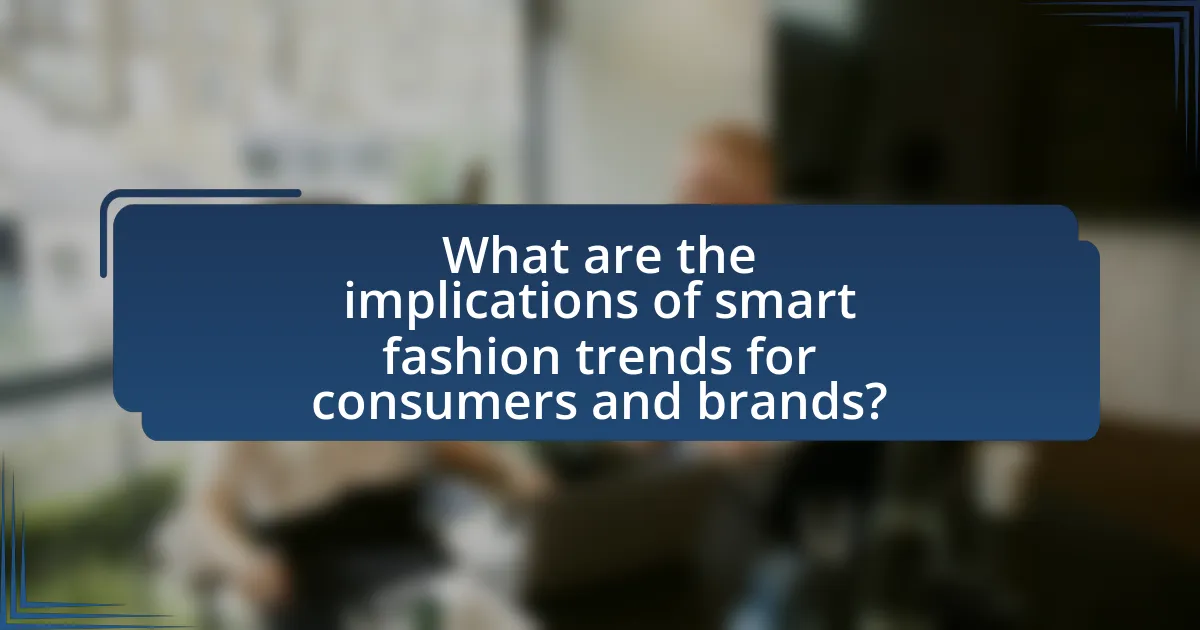
What are the implications of smart fashion trends for consumers and brands?
Smart fashion trends significantly impact consumers and brands by enhancing personalization and driving innovation. For consumers, these trends offer tailored shopping experiences through data-driven insights, allowing them to find styles that match their preferences and lifestyles. Brands benefit by leveraging technology to create unique products, improve customer engagement, and streamline supply chains. According to a report by McKinsey & Company, 70% of consumers are more likely to purchase from brands that offer personalized experiences, highlighting the importance of smart fashion in meeting consumer demands.
How can consumers navigate the smart fashion landscape effectively?
Consumers can navigate the smart fashion landscape effectively by leveraging technology and social media to make informed purchasing decisions. Utilizing apps and platforms that aggregate reviews, trends, and influencer recommendations allows consumers to assess the quality and style of smart fashion items. For instance, platforms like Instagram and TikTok provide real-time insights into popular trends and user experiences, enabling consumers to stay updated on the latest smart fashion innovations. Additionally, consumers should prioritize brands that emphasize sustainability and ethical practices, as these factors are increasingly important in the smart fashion sector. Research indicates that 66% of consumers are willing to pay more for sustainable brands, highlighting the growing demand for responsible fashion choices.
What tips can consumers follow to make informed fashion choices?
Consumers can make informed fashion choices by researching brands for ethical practices, understanding their personal style, and prioritizing quality over quantity. Researching brands involves checking for transparency in sourcing, labor practices, and sustainability efforts, which can be verified through resources like the Fashion Transparency Index. Understanding personal style helps consumers select pieces that align with their preferences and lifestyle, reducing impulse purchases influenced by social media trends. Prioritizing quality ensures longevity and reduces waste, as high-quality garments often last longer than fast fashion items.
How can consumers identify authentic influencers in smart fashion?
Consumers can identify authentic influencers in smart fashion by evaluating their engagement metrics, content quality, and transparency. Authentic influencers typically have a high level of interaction with their audience, demonstrated through likes, comments, and shares that exceed industry averages. For instance, a study by Influencer Marketing Hub found that influencers with genuine followings often achieve engagement rates of 3% to 6%, while those with inflated follower counts may show significantly lower rates. Additionally, authentic influencers produce high-quality, original content that aligns with their personal brand and values, rather than relying solely on sponsored posts. Transparency is also crucial; influencers who disclose partnerships and sponsorships in compliance with FTC guidelines are more likely to be viewed as credible.
What best practices should brands adopt in the age of social media?
Brands should adopt a strategy that emphasizes authenticity, engagement, and data-driven decision-making in the age of social media. Authenticity builds trust; consumers are more likely to support brands that present genuine messages and values. Engagement is crucial; brands should actively interact with their audience through comments, shares, and user-generated content to foster community and loyalty. Data-driven decision-making allows brands to analyze social media metrics to understand consumer behavior and preferences, enabling them to tailor their strategies effectively. For instance, a study by Sprout Social found that 70% of consumers feel more connected to a brand when the brand engages with them on social media, highlighting the importance of these practices.
How can brands build authentic relationships with influencers?
Brands can build authentic relationships with influencers by prioritizing genuine engagement and collaboration. Establishing open communication channels allows brands to understand influencers’ values and audiences, fostering trust. For instance, brands that align their messaging with an influencer’s personal brand often see higher engagement rates, as evidenced by a study from the Digital Marketing Institute, which found that 70% of consumers are more likely to trust a brand when it collaborates authentically with influencers. Additionally, providing influencers with creative freedom to express their unique voice in campaigns enhances authenticity, leading to more relatable content that resonates with their followers.
What are the key elements of a successful smart fashion campaign?
The key elements of a successful smart fashion campaign include a clear target audience, innovative technology integration, engaging storytelling, and effective use of social media influencers. A clear target audience ensures that the campaign resonates with specific consumer demographics, enhancing engagement and conversion rates. Innovative technology integration, such as augmented reality or wearable tech, captivates consumers and differentiates the brand in a competitive market. Engaging storytelling creates an emotional connection with the audience, fostering brand loyalty. Effective use of social media influencers amplifies reach and credibility, as influencers can sway their followers’ purchasing decisions. These elements collectively contribute to the campaign’s success by aligning with consumer interests and leveraging modern marketing strategies.
What future trends can we expect in smart fashion influenced by social media?
Future trends in smart fashion influenced by social media include increased personalization, augmented reality (AR) experiences, and sustainability initiatives. Personalization will be driven by data analytics from social media platforms, allowing brands to tailor products to individual preferences. Augmented reality will enable virtual try-ons, enhancing consumer engagement and reducing return rates; for instance, platforms like Instagram are already integrating AR features for fashion brands. Sustainability will gain traction as consumers increasingly demand eco-friendly practices, prompting brands to showcase their sustainable efforts through social media campaigns, aligning with the growing trend of conscious consumerism.
